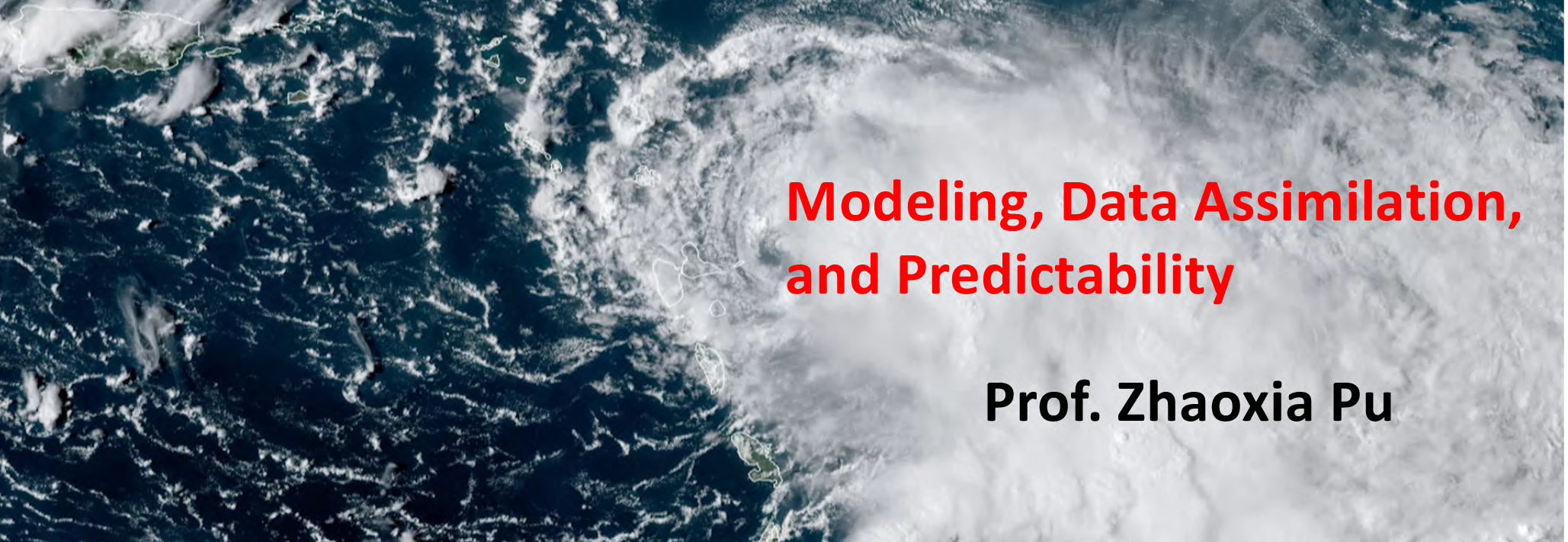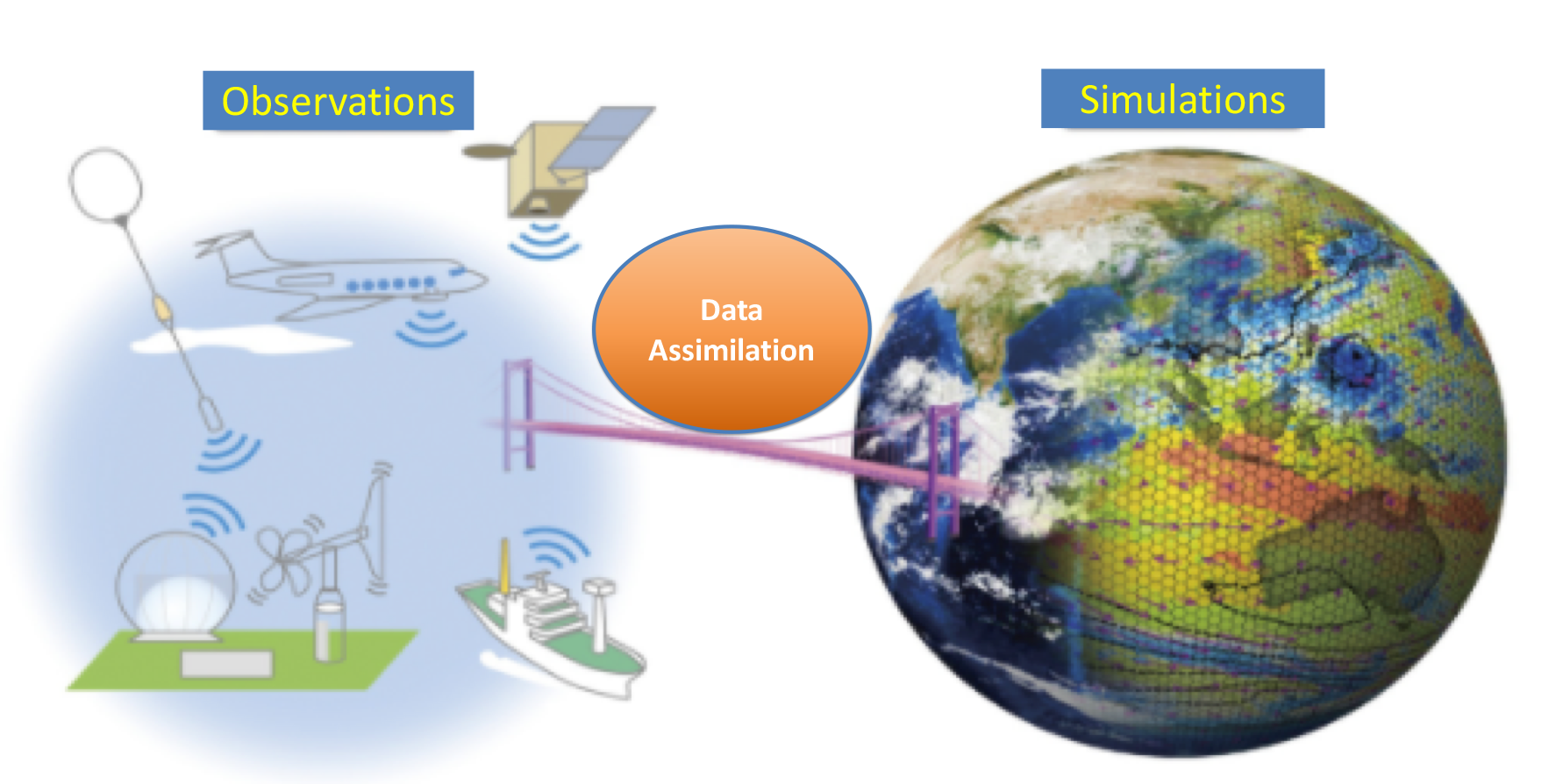- Big Data and Machine Learning in NWP
Along with advancements in the observing system, computer power, and high-resolution NWP model simulations and ensemble forecasting, NWP becomes a big data problem. Our research is expanding to explore the applications of artificial intelligence, especially machine learning, in NWP and related areas. We currently have projects collaborated with engineering interdisciplinary.
- The interaction between landfalling hurricanes and the atmospheric boundary layer
Accurate forecasts of the intensity and structure of a hurricane at landfall can save lives and mitigate social impacts. However, among recent efforts in hurricane forecast improvements, few studies have focused on landfal
ling hurricanes. This reflects the complexity of predicting hurricane landfalls and the uncertainties in repres
enting the atmospheric boundary layer conditions in numerical weather prediction (NWP) models. The aim of our research is to study the interaction between landfalling hurricanes and the atmospheric boundary layer using ensemble-based data assimilation.
We incorporate the airborne Doppler radar and ground-based NEXRAD observations with other available in-situ and satellite data into an ensemble data assimilation system with the community mesoscale weather research and forecasting (WRF) model to address the related science questions.
- Mountain Terrain Atmospheric Modeling and Observations
Taking advantage of Utah's location in Intermountain West, our study focuses the predictability of flows over mountainous terrain at mesoscale, in particular, the error growth (i.e., the sensitivity to initial conditions at various lead times), and develop meaningful measures of skill relative to appropriate conditional climatologies (i.e., the skill of capturing specific phenomena when they are supposed to appear; e.g., turbulence generation when a Richardson number criterion is satisfied). Specifically, our research emphasizes on investigating the sensitivities of model forecasts to input properties (initial conditions and model parameters) and boundary conditions, data assimilation, and comparison of different techniques (e.g., 4DVAR, ensemble Kalman filtering, 3DVAR) for their abilities in analyses and forecasts over the regions of complex terrain.
Dr. Pu is currently leading an NSF funded science project and field campiagn for better understanding, observing,modeling, and prediction of cold fog over complex terrain. For more information, see link to CFACT website.
- Tropical Cyclones and Tropical Convection
Area #1: Tropical Cyclone/Hurricane: The objective of our study is to investigate large-scale environmental conditions, mesoscale phenomena and small scale convective bursts as well as their interactions that are responsible for TC formation and intensity changes. Specific areas include 1) Characterize the intensity of convection over the western Pacific and Atlantic oceans from radar, aircraft and satellite data; 2) Derive an accurate mesoscale environment of convective systems through the assimilation of satellite, radar, lidar and in-situ data; 3) Evaluate the quality of the global forecast system (e.g., NCEP GFS and GEFS ensembles) for accurate TC analyses and forecasts; 4) Understand the environmental factors that determine tropical cyclone formation and rapid intensification.
/aims
Area #2: Tropical Convection Over Atlantic Ocean: Understanding the properties of convective systems associated with the Inter-Tropical Convergence Zone (ITCZ), African Easterly Wave (AEW), and Saharan Air Layer (SAL) is a critical area of research for improving weather and climate prediction in the Tropical Eastern Atlantic Ocean. Yet it is a challenging problem due to lack of observations and high-resolution analysis. Most of the current available global analyses are too coarse to resolve the convective systems and their associated environmental conditions. Fine-resolution analysis is necessary for progress in this area of research. In 2021 and 2022, NASA is leading field programs of weather and atmospheric dynamics investigations (CPEX-AW and CPEX-CV) based out of the Atlantic Ocean. Our research aims at assimilating data from the field campaign and NASA satellites to advance fundamental knowledge of convective initiation and life cycles over the Tropical Eastern Atlantic Ocean and their relationship with environmental conditions, especially the atmospheric boundary layer, surface winds, and low-, middle-, and upper-level convergence/divergence conditions.
Area #3: Tropical Convection Over Maritime Continet: The overarching goal of this project is to use NASA satellite multi-sensor data from TERRA, AQUA, SUOMI NPP, and JPSS in cloud-permitting-scale (~1 km) numerical simulations with the mesoscale community Weather Research and Forecasting (WRF) model, and an advanced data assimilation system to enhance our understanding of the diurnal cycle of precipitation (DCP) and winds over the Maritime Continent region and their interaction with MJO.
Past Ph. D. and M. S. Students and Research Topics (years denote the graduation years)
- [1]L. Xu, 2007: Seasonal variations of snow cover over the Tibetan Plateau and ultimate effects on the East Asian summer monsoon. M. S. Thesis.
- [2]X. Li, 2008: High-resolution numerical simulations of tropical cyclone intensity change with assimilation of satellite, radar and in-situ data. Ph.D. Dissertation.
- [3]A. Snyder, 2009: Tacking and verification of tropical cyclone development in global ensemble prediction systems: Evaluations during recent field programs. M. S. Thesis.
- [4]L. Thatcher, 2010: How vertical wind shear affects the rapid intensification of Typhoon Jangmi (2008). M.S. Thesis.
- [5]M. Ma, 2011: Numerical simulations of the extreme atmospheric boundary layer heights over Northwest China and their impacts on chemical tracer transportations. Ph.D. Dissertation.
- [6]L. Wei, 2012: Numerical simulation of wintertime inversion and data assimilating of late spring convection. Ph.D. Dissertation.
- [7]X. Zhang, 2013: Practical implementation of an ensemble transform Kalman filter.
M. S. Project. Computational Engineering Science Program.
- [8]L. Thatcher, 2013: High-resolution ensemble error growth and dimensionality in tropical cyclone genesis environments. Ph.D. Dissertation.
- [9] Z. Li, 2013: Studying the genesis of Typhoon Nuri (2008) with high-resolution numerical simulations and data assimilation. Ph.D. Dissertation.
- [10]H. Zhang, 2014: Ensemble Kalman filter data assimilation in regions of complex terrain. Ph.D. Dissertation.
- [11]C. Lin, 2014: Evaluation of double-moment representation of warm-rain and Ice
hydrometeors in bulk microphysical parameterization. M. S. Thesis.
- [12]C. Chachere, 2016: Cold season inversion in Salt Lake City: Connections to valley
variables and numerical simulations. M. S. Thesis.
- [13]Y. Yu, 2016: Evaluation of tropical cyclone forecasts from a global model and
comparison with regional mesoscale numerical simulations of Hurricane Joaquin. M. S.
Thesis.
- [14]N. Hock, 2017: Numerical simulations and sensitivity studies of a Florida sea breeze and
its associated convection in the gray-zone spacing. M. S. Thesis.
- [15]C. Yu, 2017: The impact of assimilation of GPM clear-sky radiance on hurricane
forecasts with HWRF model. M. S. Thesis.
- [16] F. Zhang, 2017: Influences of boundary layer vertical mixing and land surface
parameterizations on numerical simulations of landfalling hurricanes. Ph.D. Dissertation.
- [17] S. Zhang, 2017: Improving hurricane vortex initialization and prediction through
inner-core data assimilation with ensemble-variational hybrid methods. Ph.D. Dissertation.
- [18] P. Saunders, 2019: Studying the sudden onset and evolution of outer
rainband
precipitation of Hurricane Harvey (2017) using numerical simulations
with data assimilation and cloud initiation. Ph.D. Dissertation.
- [19] Z. Cui, 2020: Assimilation of satellite-derived winds and soil moisture data for
improved high-impact weather and short-range climate prediction. , Ph.D. Dissertation.
- [20] D. Hodges, 2020: Interactions between low-level jets and precipitation extremes with
climatology, mesoscale numerical simulations, and ensemble-based non-Gaussian data
assimilation. Ph.D. Dissertation.
- [21] X. Li, 2020: Characteristics and effects of turbulent structure in the atmospheric boundary
layer driven by weak and strong forcings. Ph.D. Dissertation.
- [22] B. Zhu, 2022: The diurnal variation and offshore propagation of precipitation at western
Sumatra coast under the winter MJO
, Ph.D. Dissertation.
- [23] M. Pletcher, 2022: Numerical simulation of ITCZ convection, the Saharan air layer, and
an easterly wave in the tropical Atlantic Ocean and Caribbean Sea during NASA CPEX-AW., M. S. Thesis.
- [24] R. Beal, 2023: Evaluation of near-surface and boundary-layer meteorological
conditions of fog formation with cold fog amongst complex terrain observations and
validation of high-resolution model simulations.
, M. S. Thesis.
- [25] Chengfeng Feng, 2024: Assimilation of All-Sky GOES-16 Water Vapor Channels, Aeolus
Satellite Winds, and Airborne Lidar Observations for Improved Numerical Simulations of
Tropical Cyclones and Tropical Convection. Ph.D. dissertation.
- [26]. Micheal Pye, 2024: The western united states drought of 2021 and 2022: synoptic scale
conditions, the response of soil moisture, and interactions with the north American monsoon. , M.S. Thesis.
- [27] Johnathan Stoddard,2025: Assimilating CYGNSS Ocean Surface Winds to Improve the Numerical Prediction of Tropical Cyclones Using the Hurricane Analysis and Forecast System (HAFS). M. S. Thesis.
- [28] Alexander Garber, 2025: Influence of Dust Aerosols on the Evolution of
Tropical Storm Hermine , M. S. Thesis.
Research Facilities
The group uses the community Weather Research and Forecasting (WRF) model and its data assimilation systems (e.g., 3DVAR, 4DVAR, EnKF, DART, GSI) as basic research tools. Major research efforts in most recent activities involve the use of various types of satellite and airborne observations from NASA, NOAA and research communities. The group also uses the research version of NCEP operational models such as HWRF, GFS, FV3GFS and 3DEnVAR and 4DEnVAR data assimilation system as research tools.
The research group maintains an excellent track in the areas of atmospheric data assimilation and mesoscale numerical simulations. Recent developments are highlighted by assimilation of satellite and radar data, high-resolution numerical simulations of the hurricane and frontal systems, model validation and satellite data analysis. Most recent research efforts also included couple land-atmospheric data assimilation, atmospheric boundary layer, numerical simulation of high-impact weather systems (e.g., landfalling hurricanes, mesoscale convective systems, fog and winter storms), as well as interactions between tropical convection and MJO. We have the broad spectrum of research areas with continuous growth.
Our research laboratory is well-equipped by personal computers, four workstations (each has > 16 CPUs and > 64GB memory); and >500 TB hard disk spaces, as well as our own Linux cluster nodes that are available all the time for our group members. As of fall 2018, our group has 24 cluster nodes with a total of 512 CPUs to support our research needs. With the availability of these computer nodes, we have recently built up a real-time forecast capability. The group members also have access to the large Linux cluster (with more than 3000 CPUs) from the University of Utah's Center for High-Performance Computing(CHPC). Also, the group gets external computing recourses through NOAA, NASA, NSF, and other government agencies.

|


